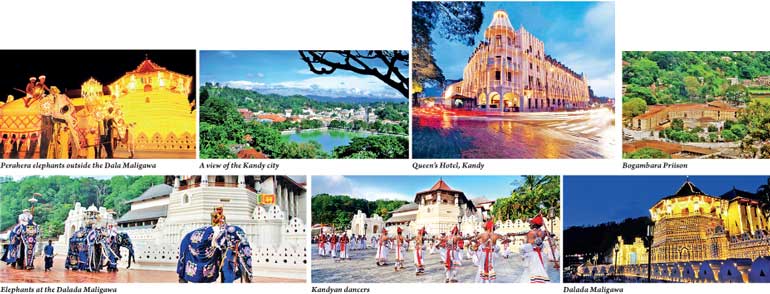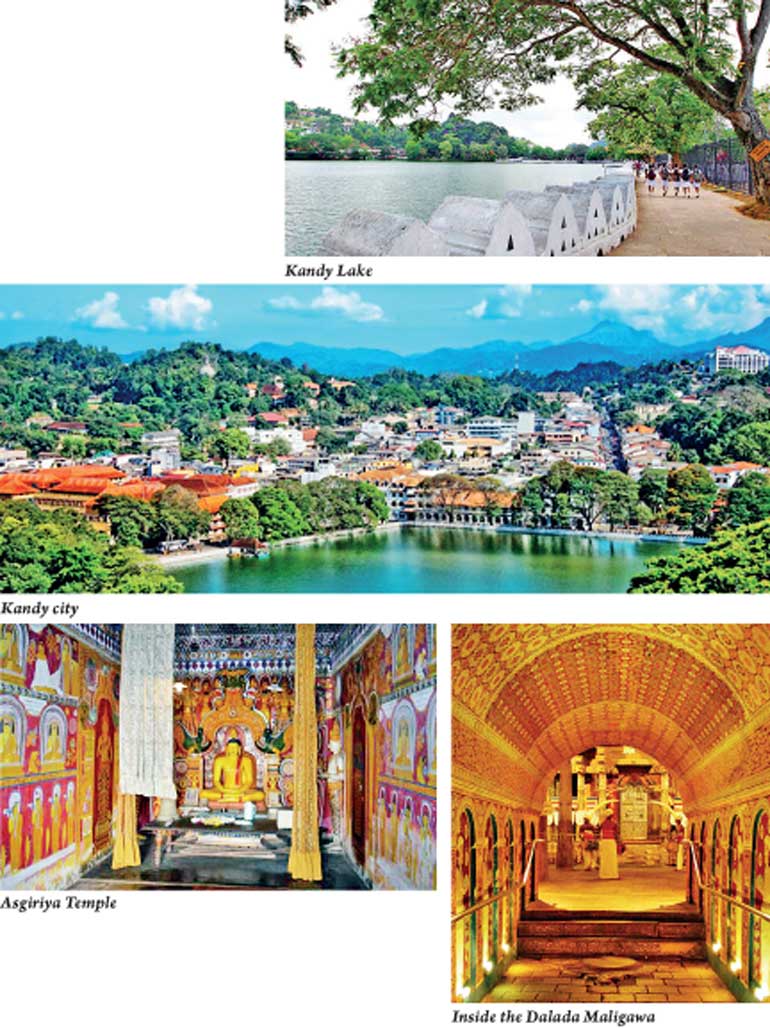Friday Mar 21, 2025
Friday Mar 21, 2025
Saturday, 27 January 2018 00:21 - - {{hitsCtrl.values.hits}}

By D.C. Ranatunga
Kandy is to be developed as a tourist hub, the Prime Minister recently announced. Visiting the site of the Bogambara prison, which from British times occupied prime land in the centre of the city, he said it would be turned into a cultural and tourist centre. He made it a point to say that the changes would be done after consulting the Malwatte and Asgiriya Mahanayaka Theras.
The news will certainly be welcomed by one and all since all these years there has not been a planned approach to develop Kandy to attract tourists although everyone took it for granted that it was so. True the Kandy Perahera drew large crowds, but beyond that not much attempt was made to ‘sell’ Kandy.
Reference has been made to the beauty of Kandy by several foreign writers in early days.
Dr. John Davy (1790-1868), who served in Ceylon after joining the British Army Medical Department, wrote in 1820: “The principal objects in Kandy worthy of any notice are the Palace, and the different temples of the Boodhoo and the gods. The Palace did occupy a considerable space of ground. Its front about 200 yards long, made rather an appearance: its front about 200 yards long looked towards the temples and rose above a handsome moat the walls of which were pierced by triangular cavities for purposes of illumination.”
Henry W. Cave, writing in 1910, stated that the most experienced travellers usually awarded Kandy the high distinction of being the most picturesque spot of the British Empire.
“The formation of the town itself may be described as a basin in the hills, the bottom being occupied in one part by the native quarters, temples and ‘pansalas’, and the rest by a picturesque lake, around which many mile of carriage drives , bridle roads and walls , at various elevations line the hill sides, which are studded with pretty bungalows. “Kandy is incomparably beautiful; but let it be at once understood that in thus describing it we are not limiting the epithet to the town and its immediate surroundings. It is rather the Kandyan country as a whole that is thus distinguished, and it must be seen from the hill-tops which command the far-reaching valleys where the Mahaweliganga rolls over rocky channels and through scenes of almost majestic beauty; from the Hunnasgeria peak; from Mattanapatana; from Lady Horton’s Walk and other steep acclivities that encircle the town itself.”
Kandy city is one place where travellers can easily walk along the main streets and cover most of the places of interest. Sri Dalada Veediya takes you to the Dalada Maligawa, the Temple of the Tooth, the most venerated Buddhist place of worship housing the Buddha’s Tooth Relic. Dating back to the 18th century, the Dalada Maligawa, apart from its religious and historical significance also displays traditional Kandyan art and architecture. The walls, the ceiling, the columns and the rood are richly adorned with traditional motifs.
The present shrine where the Relic is deposited was built by King Narendra Sinha (1707-93). The towered gateway and the moat seen today have been added later. A fine example of the typical Kandyan moonstone (‘sandakada pahana’) can be seen as the step from the main entrance adorned by a ‘makara thorana’. A passage decorated with coloured figures leads to a second door which opens into a spacious area. Here the visitor is able to see the flute players and drummers provide music while rituals are conducted in the inner chamber at specified times every day.
The last king of Kandy, Sri Vikrama Rajaisnghe (1708-1815) added the Octagon known as the ‘pattirippuwa’ which houses the collection of ancient palm leaf manuscripts.
Housed in two upper floors of the new wing of the Dalada Maligawa is a collection of women’s jewellery, ivory carvings, plaques and old manuscripts. The constant movement of the Tooth Relic due to numerous forms of threats has been recorded through a well-executed series of wall paintings by Upasena Gunawardena, renowned painter of contemporary times.
The Audience Hall, commonly referred to as the ‘magul maduva’, used by the kings for administrative and judicial purposes and on ceremonial occasions, is one of the best examples of timber architecture of the Kandyan period. It consists of 64 exquisitely carved timber columns in four rows, two on either side of the centre aisle.
One time royal residences are now occupied by the archaeological museum. The royal armoury, the bathing and dressing chamber of the king and the queen’s chambers can be seen in this complex.

The lake in the centre of the city is a landmark site. In ‘The guide to the Cultural Triangle of Sri Lanka’, Edmund Jayasuriya writes: “In the reign of King Sri Vikrama Rajasinghe there had been a paddy field separating the royal palace and the Malwatte temple complex. The king who engineered the planning and embellishment of the city had summoned his architect and asked him whether he could transform Kandy into a celestial city. Undaunted by the challenge the architect had told the king that such an idea was possible if the forest behind the palace was taken as blue clouds, cloud-walls of white were created in front of the palace and the paddy field was converted into a lake so that the reflection of the palace and the cloud-walls in the water would give the celestial appearance to the city. Pleased by the grandiose concept the king converted the paddy field into the lake we see today, which adds to the beauty of the city giving it a unique front.”
Henry Cave describes a trip round the lake: “Two roads encircle the lake – the lower at the water’s edge and the upper at a high elevation on the hill-sides. We choose the latter, and no sooner we ascended to a moderate height, than a series of beautiful landscapes is presented to us through openings in the shrubs and trees which border the road. As we wind about the varied curves, the eve-changing aspect of the town and surrounding country presents a constant difference of outline and colour which is most enchanting.”
Among other interesting places to visit are the Malwatte and Asgiriya temples and four devales – Natha, Vishnu, Pattini and Kataragama.

Discover Kapruka, the leading online shopping platform in Sri Lanka, where you can conveniently send Gifts and Flowers to your loved ones for any event including Valentine ’s Day. Explore a wide range of popular Shopping Categories on Kapruka, including Toys, Groceries, Electronics, Birthday Cakes, Fruits, Chocolates, Flower Bouquets, Clothing, Watches, Lingerie, Gift Sets and Jewellery. Also if you’re interested in selling with Kapruka, Partner Central by Kapruka is the best solution to start with. Moreover, through Kapruka Global Shop, you can also enjoy the convenience of purchasing products from renowned platforms like Amazon and eBay and have them delivered to Sri Lanka.
Discover Kapruka, the leading online shopping platform in Sri Lanka, where you can conveniently send Gifts and Flowers to your loved ones for any event including Valentine ’s Day. Explore a wide range of popular Shopping Categories on Kapruka, including Toys, Groceries, Electronics, Birthday Cakes, Fruits, Chocolates, Flower Bouquets, Clothing, Watches, Lingerie, Gift Sets and Jewellery. Also if you’re interested in selling with Kapruka, Partner Central by Kapruka is the best solution to start with. Moreover, through Kapruka Global Shop, you can also enjoy the convenience of purchasing products from renowned platforms like Amazon and eBay and have them delivered to Sri Lanka.